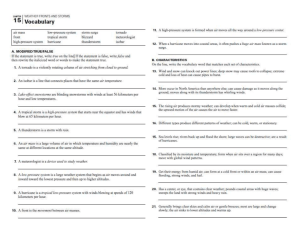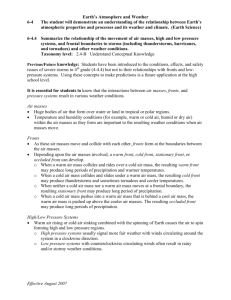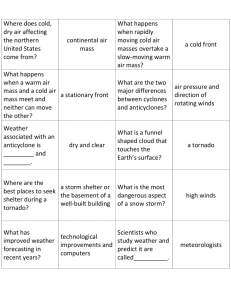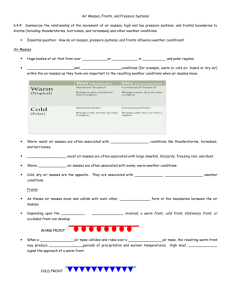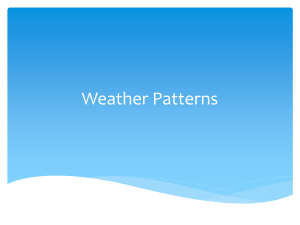Weather Patterns: Air Masses, Fronts, and Storms
advertisement
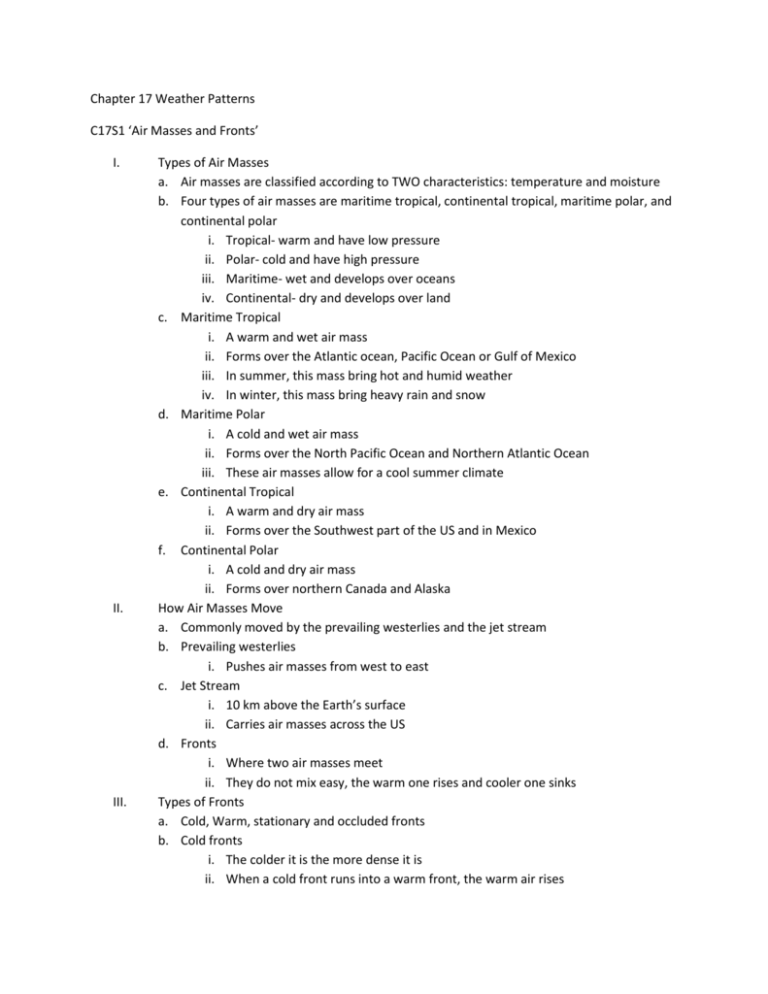
Chapter 17 Weather Patterns C17S1 ‘Air Masses and Fronts’ I. II. III. Types of Air Masses a. Air masses are classified according to TWO characteristics: temperature and moisture b. Four types of air masses are maritime tropical, continental tropical, maritime polar, and continental polar i. Tropical- warm and have low pressure ii. Polar- cold and have high pressure iii. Maritime- wet and develops over oceans iv. Continental- dry and develops over land c. Maritime Tropical i. A warm and wet air mass ii. Forms over the Atlantic ocean, Pacific Ocean or Gulf of Mexico iii. In summer, this mass bring hot and humid weather iv. In winter, this mass bring heavy rain and snow d. Maritime Polar i. A cold and wet air mass ii. Forms over the North Pacific Ocean and Northern Atlantic Ocean iii. These air masses allow for a cool summer climate e. Continental Tropical i. A warm and dry air mass ii. Forms over the Southwest part of the US and in Mexico f. Continental Polar i. A cold and dry air mass ii. Forms over northern Canada and Alaska How Air Masses Move a. Commonly moved by the prevailing westerlies and the jet stream b. Prevailing westerlies i. Pushes air masses from west to east c. Jet Stream i. 10 km above the Earth’s surface ii. Carries air masses across the US d. Fronts i. Where two air masses meet ii. They do not mix easy, the warm one rises and cooler one sinks Types of Fronts a. Cold, Warm, stationary and occluded fronts b. Cold fronts i. The colder it is the more dense it is ii. When a cold front runs into a warm front, the warm air rises IV. iii. If the air has enough moisture clouds will form iv. Cause abrupt changes in the weather (thunderstorms) v. After passing, the area is cooler, drier, and have clear skies c. Warm Front i. Warm air overtakes the cold air ii. The warm air rises top on top of the cold air iii. If there is enough moisture precipitation will occur iv. Could be rainy for several days at a time d. Stationary Front i. Cold and warm air masses meet, but neither one can move the other one ii. Day of precipitation and clouds are likely with enough moisture present e. Occluded Front i. Warm air is caught between two cold air masses ii. The two cold air masses squeeze the warm air up Cyclones and Anticyclones a. Front collide and can sometimes swirl b. Cyclone i. Low pressure systems ii. Cloud will form, it will be windy and cooler iii. Spin in a counterclockwise motion due to the Coriolis Effect (Northern) c. Anticyclones i. High pressure systems ii. Sunny and dry air iii. Spin In a clockwise direction due to the Coriolis Effect (Northern) C17S2 ‘Storms’ I. Storm- a violent disturbance in the atmosphere Thunderstorms a. How Thunderstorms Form a. Storm with heavy precipitation, thunder, and lightning b. Come from cumulonimbus clouds on hot, humid afternoons c. Associated with cold fronts d. A lot of up and down drafts b. Lightning and Thunder a. Areas of + and – electrical charges build up in a storm b. Lightning- a sudden spark as charges jump from the cloud to cloud, or cloud to the ground c. Lightning can heat the air to upward of 30,000 degrees Celsius d. Thunder occurs when the air quickly expands and explodes c. Thunderstorm Damage a. Floods b. Can cause fires d. Floods a. When rivers get too full b. When the ground become too saturated e. Thunderstorm Safety a. Stay indoors during a thunderstorm b. While indoors, stay away from items that conduct electricity c. If stuck outside, go to a low lying area away from trees II. Tornadoes Tornadoes- whirling storms which are the most destructive a. How tornadoes form 1. Come from the most intense thunderstorm 2. Likely during storms in the spring or summer 3. Occur along cold fronts b. Tornado Alley 1. Area in the Great Plains from Texas to Iowa 2. Sometimes more than 800 per year could be found in this area c. Tornado Damage 1. Comes from winds and flying debris 2. Very unpredictable storms 3. Ranked from an F0 to F5 on the Fujita scale d. Tornado Saftey 1. During a tornado warning, seek shelter in a basement 2. If no basement, move to the middle of the ground floor III. Hurricanes Hurricane- tropical cyclone with winds of 119 mph or higher a. How Hurricanes Form 1. Form as low pressure systems off the coast of Africa 2. Draw energy from warm water in near the equator 3. Inside the storm are strong winds and heavy rain 4. The lower the pressure, the stronger the winds 5. The center of the storm or ‘eye’ is usually clear when it passes b. How Hurricanes Move 1. Can last a week or more 2. The hurricanes effecting the US are steered by the trade winds 3. Once over land, the hurricane loses strength c. Hurricane Damage 1. High waves and severe flooding and wind damage 2. Low pressure and high winds cause a storm surge a. A ‘dome’ of water b. Can destroy beaches and buildings d. Hurricane Safety 1. Advances in warning have been made 2. Watches and warning indicate possible evacuation IV. Winter Storms a. Heavy snow can cause road blockages and can trap people b. Water pipes can freeze and burst c. Lake –Effect Snow 1. Northeast is effected by such events 2. Lake Ontario provides the moisture for such a snow storm d. Snow Storm safety 1. If stuck in a snow storm, try to find shelter from the wind C17S3 ‘Predicting the Weather’ I. II. Weather Forecasting a. Data needs to be collected i. Observation ii. Using different instruments b. Making Simple Observations i. Types of clouds ii. Meteorologist- scientists who study the causes of weather and try to predict it c. Interpreting Complex Data i. Sources of data 1. Local weather observers 2. Weather balloons or satellites 3. Weather stations from around the world 4. Radar equipment 5. Most information comes from the National Weather Service Weather Technology a. Now, short range forecasts are fair reliable b. Computers have help a lot in forecasting advances c. Weather Balloons i. Carry instruments into the upper troposphere and stratosphere ii. Measurement of temperature, air pressure, and humidity can be taken d. Weather Satelites i. 1st satellite was launched in 1960 ii. Images of clouds, storms and snow cover can be taken iii. NASA’s Terra satellite can also gather information such as temperature, humidity, solar radiation, and track storms and storm systems e. Automated Weather Stations i. Stations on the surface of the Earth ii. Calculate temperature, air pressure, relative humidity, rainfall, and wind f. III. Computer Forecasts i. Processes information quickly and can provide models of possible upcoming weather situations ii. Quickly revised forecasts come up every few minutes Reading Weather Maps a. Weather Service Maps i. Snapshot of the weather during a certain time over an area ii. Weather map usually use symbols to represent different weather conditions iii. Curved lines connect place with certain conditions 1. Isobar- connect points of equal pressure on a weather map 2. Isotherms- connect points of equal temperature on a weather map b. Newspaper Weather Maps i. Produced by the NWS ii. Knowledge of Symbols are need to read weather maps c. Limits of Weather Forecasts i. Great accuracy is still a problem with weather forecasting ii. Butterfly Effect- if something happens in one place In the world, it cause something different to happen in another area of the world iii. A small change today could mean a large change tomorrow

